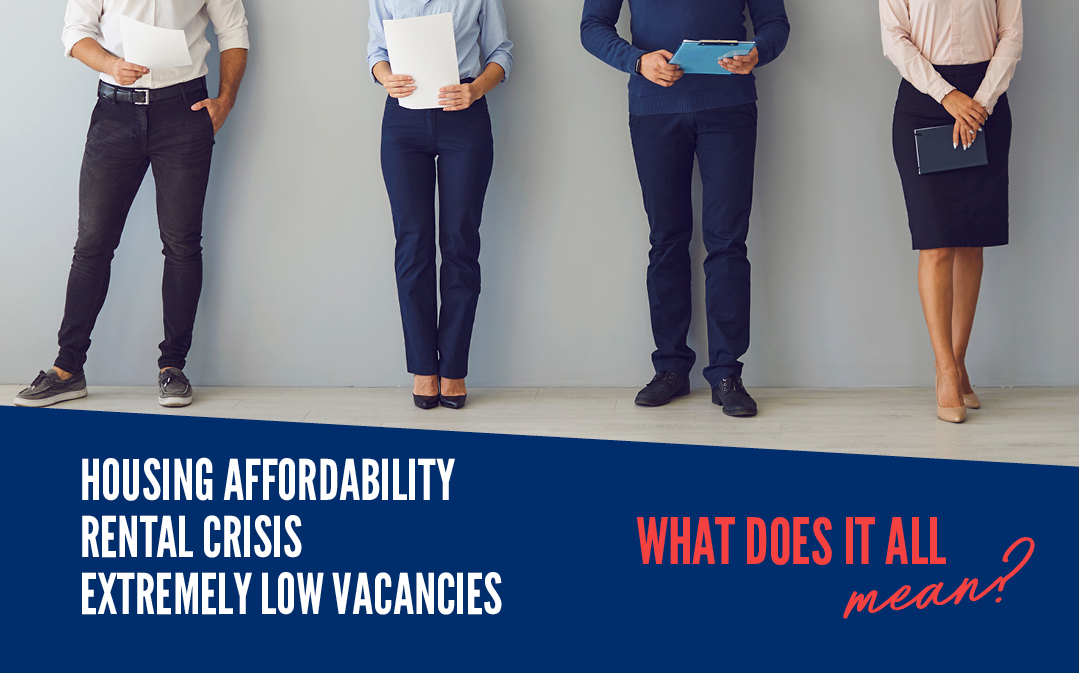Are housing affordability & low rental vacancies driving the rental crisis?
There wasn’t much love in the recent Australian Property Investor magazine headline on 14th Feb 2023 declaring “Rental crisis only going from bad to worse”.
With the last few years of highs and lows in the rental market, the situation shows no sign of stabilising just yet. There are several factors that have contributed to the current position, including a lack of affordable housing, extremely low vacancies, and increased demand. In this blog post, we’ll take a look at these issues and explore how they’re impacting property investors in the Australian Defence Force.
Capital Properties’ Property Investment Tools & Apps will help you adapt to changes in the property market. If you’re just getting started with property investment, then you should come along to our free Capital Properties Discovery Session.
Already on-board? Make the most of our ongoing guidance with our Capital Properties Pinnacle Support Program.
On the go? Here’s 30 seconds of take outs:
- Median rent values have increased by 22.2% in a year (Sept 2021 – 2022)
- Rental vacancy rates have fallen to their lowest level in over a decade.
- Demand for housing far outweighs supply
- There are calls for regulations to short-term letting in popular tourist areas.
- The Federal Government has announced a $10 billion Housing Australia Future Fund for 30,000 new homes in the next 5 years.
- As part of the Victorian Labor Government’s Big Housing Build they’ve committed $50 million to build 130 new homes for youth in regional areas.
- Asproperty prices look set to fall there are some great opportunities for investors and first home buyers.
Keep reading >>
How did the Australian rental crisis begin?
When COVID-19 first struck in early 2020, Australia’s economy (as well as many other global economies) fell into a brief recession caused by lockdowns and reduced migration. This resulted in plummeting rents. Suddenly CBD apartments were sitting empty, and landlords dropped rents to attract tenants.
However, within mere months the tide began to turn and after September 2020 the rental market began to recover. In fact, the recovery was so immense that in the past two years we’ve seen a surge in the median rent value by a whopping 22.2%. So, what’s driving this change? Let’s look at some of the factors involved:
Demand > supply
Put simply, demand is greater than supply. This effectively means there are not enough homes to keep up with increased population and housing demand. In the year from June 2020 to 2021 there were 214,819 new houses built in Australia. The following year, from June 2021 to June 2022 there were only 174,931 houses built – that’s a shortfall of almost 40,000 houses (18.6% less than the year prior)! Since then, worker shortages, increased building costs and supply chain problems have resulted in many builders stalling, or worse – going bankrupt and leaving projects unfinished, further adding to housing pressures and extremely low vacancies.
Housing affordability
As property prices have steadily risen over the last few years, and surged in some desirable areas, many people have been priced out of the housing market. Some people have been waiting for the market to settle and have missed out altogether. Now with increased mortgage interest rates reducing many people’s borrowing capacity, these people have little chance of escaping the rental rat-race.
Changing family structures
After years of declining divorce rates, the pandemic through 2021 saw an uptick in divorces and presumably a higher percentage of separations – although there’s no data available to demonstrate just how many. The division in these households puts more demand on rental housing.
Internal migration
Between 2016 and 2021, 184,000 people moved from capital cities to regional areas – that’s more than double the rate of internal migration reported in the 2016 Census. This significant shift created unprecedented demand in regional and rural areas putting huge pressure on local vacancy rates.
International migration
Although it might take a little longer before we’re back up to previous immigration numbers, the return of overseas students and travellers means that an already burdened rental market is struggling to cope. As the Labour Government has promised a huge hike in skilled visas this year, this will add even further demand.
The Airbnb effect
The impact of short-term letting through providers like Airbnb and Stayz has made housing affordability a real problem in tourism-rich regional and coastal areas. In some holiday areas such as Byron Bay in NSW, the Gold Coast in Queensland or the Mornington Peninsula in VIC, short-term rentals are having a major impact on supply. This is forcing some states to review the impact of short-term stays and there are increased calls to introduce changes to regulate these markets.
Is there a rental crisis in Australia?
According to recent reports, rental vacancy rates across Australia have fallen to their lowest level in over a decade. While the national rental vacancy rate is at a record low – below 1%, it’s certainly more apparent in some areas. Sydney and Melbourne have only 1% availability, which is an all-time record-low for Melbourne.
Having fewer properties available for rent is driving up the cost of rental accommodation with the price of rent in capital cities up 17.6% for units and 14.6% for houses in 2022.
And the costs are increasing nationwide. Melbourne experienced the biggest unit rent rise with 20%, followed by Sydney (18.6%), Brisbane and Adelaide (both 14.3%), Perth (10.3 %), Hobart (9.%), Darwin (8.%) and Canberra (5.7%).
What does it mean for renters?
The declining housing availability in the rental market, rising weekly rents and ever-increasing living costs means that many people are seriously struggling.
In a recent ABC news article, Jacob Visser of Visser Estate Agents said rental availability was the worst he’d seen in more than 10 years working in the industry: “I’ve never witnessed, or experienced, the levels of crisis we are currently seeing“… “Tenants are desperate – really, really desperate,” he said.
News reports show people lining up around blocks to view houses, with sometimes up to a hundred people attending inspections. Many properties are receiving close to 30 applications and people are applying sight unseen. Some applicants are even offering higher than the advertised rent, pushing prices up for everyone. And although the rental crisis is affecting everybody, the young to early middle age population are feeling it the most.
Is the rental crisis going to get better this year?
Although the rental market is always in a state of flux, the prediction for many renters this year looks grim. The recent news that 6600 affordable homes are being removed from the National Rental Affordability Scheme this year, is adding further distress for disadvantaged renters. The scheme gave property owners a subsidy of nearly $11,000 annually for 10 years for renting out newly built houses at 20% less than the market rate. Queensland is due to lose 2500 homes, while Victoria will lose 1350, Western Australia is to lose 1100 and 605 properties gone in NSW. Plus, a further 9200 houses are to leave the scheme in 2024.
Under increasing pressure, the Federal Government have announced a $10 billion Housing Australia Future Fund to build 30,000 new social and affordable homes in the next five years. However, many campaigners are arguing that this falls far short of what is needed.
On 13th February 2023, the Victorian Labor Government announced a $50 million investment to build 10 new housing projects (more than 130 new homes) for young people across the state in Werribee, Wangaratta, Wodonga, Shepparton (Mooroopna), Bairnsdale, Mildura, Reservoir, South Morang and Frankston. This funding is part of the Labor Government’s landmark $5.3 billion Big Housing Build.
What can be done to solve the rental crisis?
A recent report by the Australian Housing and Urban Research Institute (AHURI), suggested that more assistance from the government was required to help shift more tenants into home ownership: “Investors should be encouraged to participate in social, community and affordable government housing programs.…On top of that, seeing meaningful improvements in gross rental yields this quarter will hopefully encourage investor activity helping to address supply issues.”
Taking advantage of falling property prices & government grants
As property prices look set to fall across many Australian regions this year, there are some great opportunities for investors and first home buyers.
With government grants for ADF members such as The Victorian First Home Owners Grant and The $10,000 NSW government grant as well as the Regional First Home Buyer Guarantee, there are some excellent incentives to buy a property now.
The recipe of historic low rental vacancies with high yields, makes it a dream scenario for property investors considering entering the market, or expanding their portfolio. And with attractive asset depreciation tax benefits for new properties which can attract better quality tenants, the outcome for investors looks favourable.
It’s essential for property investors to stay informed about market trends and conditions. Our Capital Properties Switched-On Strategy Series and Capital Properties Pinnacle Support Program will make sure you stay ahead of the changes.
Being strategic in your investment decisions and working with experienced property investment professionals, ADF investors can build a successful property portfolio to deliver stable rental incomes and long-term growth.






